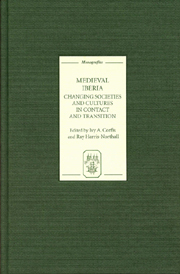Book contents
- Frontmatter
- Contents
- Acknowledgements
- Introduction
- Part 1 SOCIAL AND CULTURAL MINORITIES IN CHANGING SOCIETIES
- Part 2 CONTACT AND CONFLICT: PERSPECTIVES ON HISTORY AND CULTURE
- Part 3 TRANSMISSION OF LEARNING AND TEXTS IN CHANGING CULTURES
- Hermes Trismegistus in General Estoria II
- Pharmaceutical Fictions: Celestina's Laboratory and the Sixteenth-Century Medical Imaginary
- Spanish and Portuguese Scholars at the University of Paris in the Fourteenth and Fifteenth Centuries: The Exchange of Ideas and Texts
- The Primary Audience and Contexts of Reception of Thirteenth-Century Castilian cuaderna vía Poetry
- Editorial Interference in Amadís de Gaula and Sergas de Esplandián
- Part 4 LINGUISTIC CONTACT AND CHANGE
- Index
The Primary Audience and Contexts of Reception of Thirteenth-Century Castilian cuaderna vía Poetry
from Part 3 - TRANSMISSION OF LEARNING AND TEXTS IN CHANGING CULTURES
Published online by Cambridge University Press: 12 September 2012
- Frontmatter
- Contents
- Acknowledgements
- Introduction
- Part 1 SOCIAL AND CULTURAL MINORITIES IN CHANGING SOCIETIES
- Part 2 CONTACT AND CONFLICT: PERSPECTIVES ON HISTORY AND CULTURE
- Part 3 TRANSMISSION OF LEARNING AND TEXTS IN CHANGING CULTURES
- Hermes Trismegistus in General Estoria II
- Pharmaceutical Fictions: Celestina's Laboratory and the Sixteenth-Century Medical Imaginary
- Spanish and Portuguese Scholars at the University of Paris in the Fourteenth and Fifteenth Centuries: The Exchange of Ideas and Texts
- The Primary Audience and Contexts of Reception of Thirteenth-Century Castilian cuaderna vía Poetry
- Editorial Interference in Amadís de Gaula and Sergas de Esplandián
- Part 4 LINGUISTIC CONTACT AND CHANGE
- Index
Summary
Thirteenth-century Castilian cuaderna vía poems share a common system of literary production and communication. While the act of writing and the individual reading of sources played an essential role in their creation, these works were intended originally to be read aloud to a stable, homogeneous audience. This would explain why authors of the sources, authors of the Romance poems, scribes, vocal emitters and receptors are all inscribed in the extant texts as cocreators (Ancos García, ‘El Autor’ and ‘La forma primaria’ 396–419). For the most part, it seems clear that the authors of the vernacular poems and their scribes, as well as the authors of the sources, were male clerici, either in the cultural and/or the professional sense (Ancos García, ‘El Autor’ and ‘La forma primaria’ 420–1). Here, I shall argue that the same is true of the vocal emitter and the primary audience of most of the Romance texts.
First, I shall consider aspects of the works' immediate context of reception. In Gonzalo de Berceo's VSM, for instance, the narrator tells us that the saint-to-be flees to the area surrounding the San Lorenzo peak, where ‘encara oy en día parecen los altares, / los que estonz fizieron los sos santos polgares’ (49cd). These altars must have been near the upper monastery of San Millán and are not mentioned in Braulio's Vita S. Emiliani, the passage's Latin source.
- Type
- Chapter
- Information
- Medieval IberiaChanging Societies and Cultures in Contact and Transition, pp. 120 - 135Publisher: Boydell & BrewerPrint publication year: 2007



